The 11 Most Dignified (and Thus Reasonably Attired) Videogame Heroines
 By Todd Ciolek
By Todd Ciolek
It?s been said many times before: video games are sexist. And it will continue to be said as long as games put women in hi-tech combat bikinis and suits of cleavage-baring armor. But let?s set aside the Ivy Valentines and Lara Crofts and Tyris Flares and all of those other bad examples. Let?s seek out the rare female characters who have both genuine personalities and wardrobes that aren?t clearly fashioned to keep anyone from taking them seriously.
Let?s also set a few ground rules. We?re not going to cheat and list any women who exist only as text or nondescript character portraits. We?re also sticking to candidates who qualify as fully formed characters, so you needn?t tell us all about the stunningly self-confident and sensibly attired night elf you play in World of Warcraft. We?re going to pick out 11 video game heroines who noticeably revolt against shameful trends. And then, because we?re cynical bastards, we?ll point out the problems that still cling to them.
11) Hilde, Soul Calibur IV
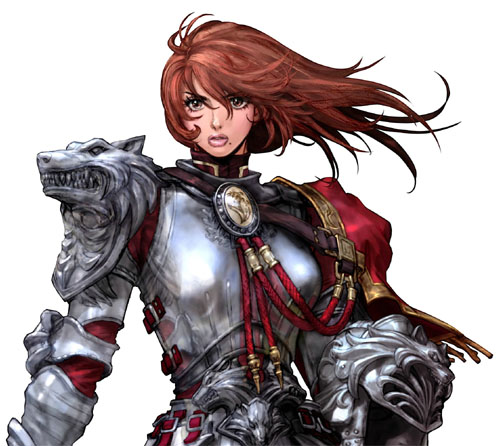
Fighting games often backhandedly rob female characters of any respect. A good example would be King from SNK?s The King of Fighters and Art of Fighting. She wears a tuxedo and seems a capable martial artist, but look closer and you?ll find that she despises her own femininity?and that her top tears off when she loses a match. For Soul Calibur IV?s cast, the developers at Namco went out of their way to add one woman who wasn?t spilling out of a tight, scant outfit, perhaps to excuse the fact that about every other female character is. Hilde, at least, wears a full suit of armor, complete with helmet, in her default costume and dons a full dress for her alternate one. And unlike other armor-clad women of fighting games, Hilde isn?t put through any ridiculous romantic contrivances. She?s all business, as far as we can tell from Soul Calibur?s incomprehensible mess of a plot. Even her full name, Hildegard von Krone, is about as sexy as a traffic sign.
BUT: Soul Calibur IV also has a character-customizing mode which can put any character into a variety of outfits. With a few simple menu choices, Hilde can be reduced to her underwear or dressed in some hideous confabulation of halter top and ninja-girl leotard. All of the characters can have their armor broken in battle, provided their opponents hit them just right. However, we?ll give Namco credit for putting Hilde?s possible degradation in the hands of the players. You filthy swine.
10) Junon, Dragon Force
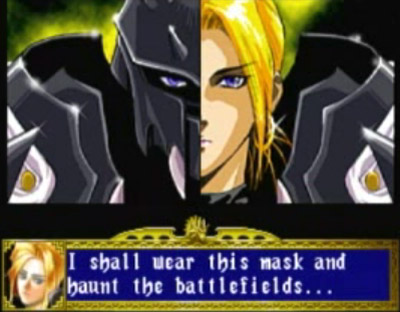
One of the generals in Sega?s excellent Saturn strategy-RPG, Junon defies any remotely demeaning character design by wearing lots of armor. And not just any armor: she wears a big, heavy suit of pitch-black armor with a foreboding, horned helmet that hides her face completely. She does it all to lead her nation out of its frigid, barren ruin after the death of her father, and she?s determined to conquer her own subcontinent while driving her enemies mad with terror at the sight of her. Hence the helmet.
BUT: For all of Junon?s rigid appearance and no-nonsense approach to conquest, she still needs a man to save her?and marry her. During a battle with one of the game?s tougher rival conquerors, Junon gets belted around and is conveniently rescued by Leon, the ruler of another kingdom and one of her allies. After the huge, world-wrecking god of darkness and evil and pollution is defeated, Junon ditches her armor and settles down to have a kid with the burly Leon, who, in some minor saving grace, at least exposes more skin than Junon does.
9) Elaine Marley, The Secret of Monkey Island

The Monkey Island titles are perhaps comedies above all else, but the first two had writing sharper than what you?ll see in a good percentage of allegedly dramatic games. So it suits things when the franchise?s recurring heroine, Elaine Marley, is more than just a vapid love interest for bumbling hero Guybrush Threepwood. When the two first meet, Elaine is already governor of an entire island, and her calm professionalism contrasts with the untested Guybrush?s player-identification stabs at adventuring. Even a plot twist that sees her kidnapped and nearly married to the undead pirate LeChuck turns out to be part of her plan, a plan undone only by Guybrush?s attempt at heroism. And at the start of the second Monkey Island, she?s the one rescuing Guybrush.
BUT: Later installments of the series weren?t quite so clever with Elaine?s role. In the third game, she?s the consummate damsel in distress, turned to gold by a cursed ring Guybrush unwittingly uses to propose to her. She spends most of the game as an enraged-looking statue. Because dames are always mad about something.
8) Chris Lightfellow, Suikoden III

The Suikoden series dodges accusations of entrenched sexism by cramming each title with over 108 playable characters. Don?t like that under-dressed rune sage who shows up in every game? Well, we?re sure there?s a perfectly respectable woman warrior or two in your massive army?s ranks. And Chris is arguably the most respectable of the franchise?s leads. She commands her own division of knights, she can hold her own in combat, and she handles most of the plot twists that Suikoden III throws her way. She also wears a near-full suit of armor for the first leg of the game and then changes into sensible traveling attire.
BUT: Chris is? well, sorta boring. She?s a bit too rational and guarded about everything, even when she?s stricken with magical battle-lust and compelled to slaughter children. Much of her storyline involves her reacting to things instead of taking any initiative. We also detect in her a few daddy issues, and those are always a lazy, chauvinistic way of giving female characters motivation. Chris is driven to become a knight by her dad?s absence, she?s set off on her quest by the promise of seeing her dad again, and her character growth hinges on finding her dad and making amends with him.
7) Alexandra Roivas, Eternal Darkness
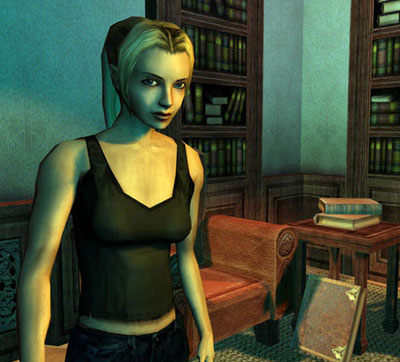
Game developers often show utterly baffling cognitive dissonance in creating female characters. They?ll take pride that they ?created strong heroines who weren?t sexualized? in a game that, upon examination, stars a college girl dicing zombies while falling out of her strapless, low-cut microdress. So you?d be forgiven for having snorted derisively when Silicon Knights? Dennis Dyack claimed that his Eternal Darkness team had ?created a female lead character that would not make the first cut on Baywatch.? Yet they pulled it off. Alexandra?s a Mathematics undergrad called upon to investigate how her grandfather became half-digested human ravioli. Naturally, it involves ancient secrets and those burbling, gibbous, preternatural, non-Euclidean ancient horrors that H.P. Lovecraft took such delight in hinting at. Despite having no evident combat training, Alex plunges into the mystery, takes a shotgun to zombies, and eventually brings about a happy Lovecraftian ending?in other words, an ending where the earth is ruled by the least threatening of hideous aberrations older than the cosmos.
BUT: Like another ?Alex? derivative on this list, Ms. Roivas isn?t so much a game stereotype as she is a cinematic one. She?s the Final Girl that every horror film needs, the determined young woman who ultimately seals the villain?s fate and lets the director evade misogyny charges, no matter how many other female characters have been gruesomely butchered. By the way, Alex, it helps to wear something with sleeves when you?re fighting unspeakable horrors from the arcane depths of human imagination.
6) Jade, Beyond Good and Evil

If Beyond Good and Evil was unfairly shunned when it arrived on every major console in 2003, it at least has tirelessly vocal fans who will never stop reminding us of how unappreciated and stereotype-defying it was. When it comes to the game?s heroine, they?re right. Jade?s a tough, staff-swinging photojournalist who?s never unfairly portrayed throughout her fight to uncover her planetary government?s shady motives. She?s fashionably dressed and attractively designed, but never crassly so, and, thanks to the game?s varied assortment of play styles, she?s able to pull off stealthy infiltrations and world-saving battles.
BUT: Jade?s so painstakingly dignified that she?s ultimately dull, going about her corruption-exposing crusade with predictable blandness. Like a lot of Beyond Good and Evil, she was apparently stitched together from the less creative parts of Disney movies, Don Bluth cartoons, and Japanese RPGs. Her story is rife with their clich?s, from the orphanage she protects to her wacky animal-person sidekick to the big revelation about how she secretly holds a godlike power capable of setting everything to rights. Never saw that one coming.
5) Fall-From-Grace, Planescape: Torment
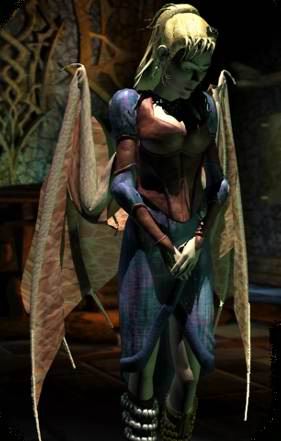
Fall-From-Grace is a succubus, a thoroughly stereotyped creature in the Dungeon & Dragons sub-universe that inspired Planescape: Torment. The catch? She?s forsaken the path of a demonic seductress in favor of celibate intellectual pursuits. When the game?s lead, himself a resurrected amnesiac corpse, finds Fall-From-Grace, she?s managing a ?Brothel of Slaking Intellectual Lusts,? where the service sold is philosophical conversation. Curious and knowledgeable, Fall-From-Grace is driven by a thirst for cerebral experience, and her backstory has her escaping slavery by besting demons at improv acting. You won?t see that in your typical chainmail-bra-busting heroine.
BUT: Once she?s joined the main character?s party, there?s still a bit of commentary on how golly-darned attractive Fall-From-Grace is (though she, like the rest of Planescape?s cast, looks like a waxen, computer-rendered mannequin). Even the game?s grossly out-of-place geometrical fantasy-robot, Nordom, flirts with her, as much as a robot can flirt. One more thing: Fall-From-Grace is useful in battle only as a magic-user, thus satisfying at least one negative practice toward women in role-playing games.
4) April Ryan, The Longest Journey and Dreamfall
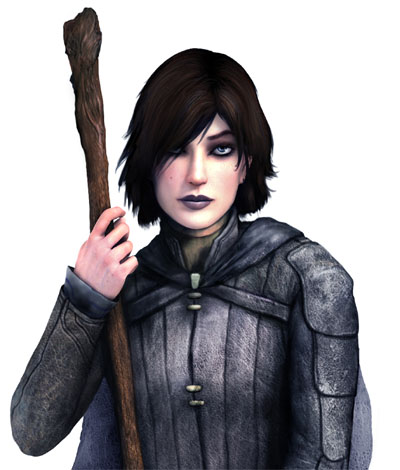
There?s a long and half-proud history of graphic adventure games featuring sensible, realistic women in leading roles, and The Longest Journey has one of the better examples. While a lot of the game forces the player to endure character monologues only slightly less dull than hearing Christmas letters read aloud, it?s at least halfway interesting when April?s investigating and dropping her well-acted observations into a sluggishly paced story. She comes across as a normal art student, slowly and sarcastically being drawn into a bizarre fantasy world. April doesn?t stay that way, though, as she shows up again in the sequel, Dreamfall, angrier and wearing heavier eye makeup,
BUT: April doesn?t have the best of starts, as the game?s first stage finds her dreaming that she?s trapped on a mountain cliff and wearing nothing but her underwear. It?s not nearly as blatant as, say, Samus Aran rewarding players by shedding clothes, and it helps that April mocks the scene, citing it as one of those dreams that we?ve all had. Still, April satisfies a player fantasy or two early in the game, when she expresses her dislike of beefy muscle-men and remarks ?Give me a nerd any day.?
3) Lenneth Valkyrie, Valkyrie Profile
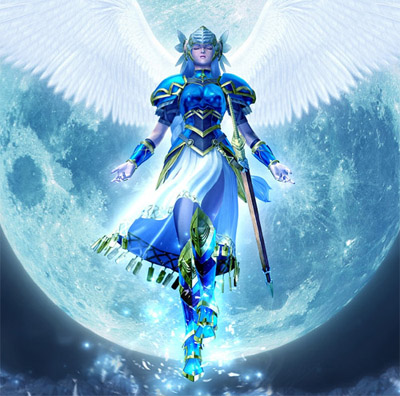
The original subtext of Norse valkyries is up for debate. In their most popularized role, they were war goddesses, plucking out the most valiant of slain combatants to join heavenly armies. On the other hand, they also served as glorified waitresses in Valhalla?s feasting halls, and one can?t help but see a bit of fantasy fulfillment in an afterlife where blonde, angelic battle-barmaids fetch some beers while you watch football with Thor and Baldur. Fortunately, Lenneth is the fearless, combat-ready type of valkyrie, and the lead in tri-Ace?s RPG take on Norse myth. As a recruiter for Odin, she assembles her own strike force of tragically dead heroes, all while ferreting out and destroying creatures of the underworld. She?s also a consistently developed heroine, gradually changing from a disdainful, regally aloof deity to a sympathetic guardian of the humans she presses into Odin?s service. Even her clich?-mandated love interest bucks convention, with her would-be boyfriend playing the weaker, sacrificial, rescue-me role. And her outfit, skirts and all, is never demeaning.
BUT: Well, her outfit was fine in the first Valkyrie Profile. For some reason, much of the art for the newer games in the series shows Lenneth with her dress blowing up like some Norse RPG mockery of that Marilyn Monroe photo. Yes, she?s now a goddess impervious to anything but strong breezes. And she was doing so well!
2) Alyx Vance, Half-Life 2
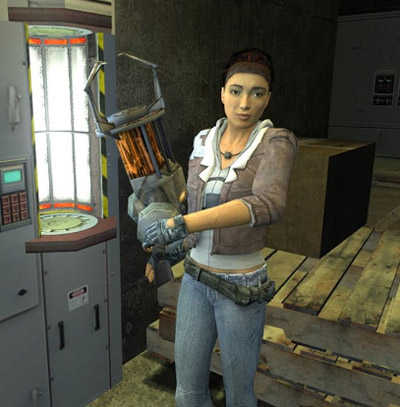
Mentioning Alyx in discussions of decent videogame women is a bit like citing a mid-career Beatles record as your favorite album. No one will argue with you, but no one will expect you to contribute anything further to the conversation at hand. Alyx is, technically, a supporting character and never playable, but she?s still the second most prominent member of the Half-Life cast, and the most visible, considering that Gordon Freeman will never grow a personality or see his feet. Alyx, in contrast, is upbeat, quick-witted, and, for the most part, realistically written.
BUT: Alyx may defy videogame clich?s, yet a critical look at her suggests another clich?: the summer movie heroine. She?s plucky! She?s attractive! She?s linked to the hero by circumstance and questionable chemistry! And she might not be overtly pandering! But hey, that?s a step up for an industry where Lara Croft could be described, straight-faced, as an empowered heroine ten years ago. The only other problem with Alyx is really a problem with Gordon; since he never says anything to her (or anyone else), Alyx?s responses to him recall some slimy Japanese dating simulator, in which maids and catgirls and schoolgirls with eye patches and cowlicks invariably coo and blush over unseen, unheard male protagonists.
1) Agrias Oaks, Final Fantasy Tactics
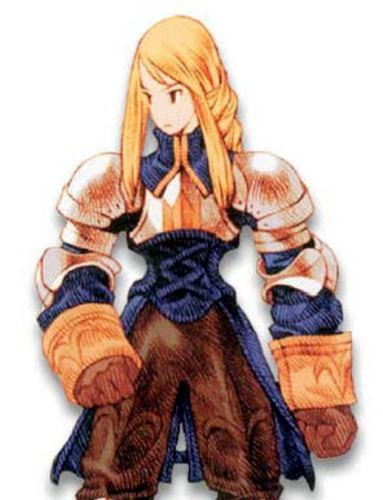
The world of Final Fantasy Tactics is a harsh one, where peasants starve, nobles butcher each other, and it?s made clear at the game?s start that the hero, Ramza, is doomed to be forgotten by history no matter what he does. It?s fitting that everyone there, man or woman, is a bit more down to earth than the usual medieval-anime-fantasy milieu. Agrias Oaks is among the first heroic allies introduced, and she?s a far cry from the typical waif of a healer-girl. In gameplay, she?s a powerful knight with lots of useful long-range attacks. In personality, she?s the efficient bodyguard of a princess, and she?s determined to see her task through in a country full of scheming bourgeois fascists and the demonic servants of Evil Jesus (yes, really). Agrias also catches the eye of her nerdiest acquaintance, an engineer named Mustadio, yet she doesn?t fall for him, as she would in more hackneyed surroundings.
BUT: When several knights attack Agrias at the start of the game, the script pauses to proclaim that Agrias has ?a beautiful face,? a revelation both unnecessary and amusing, considering that Agrias has the same noseless visage as every other character. There?s also a hidden scene wherein Mustadio gives Agrias lip rouge as a birthday present. While Agrias admits that she?s forsaken ?womanly things,? there?s a patronizing air in the game?s joke that she doesn?t realize how attractive she is. Yes, it would be a horrible shame if she were ugly.

